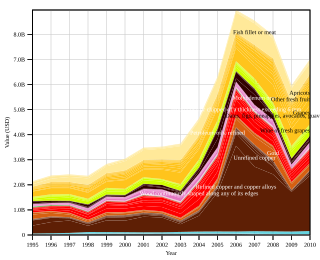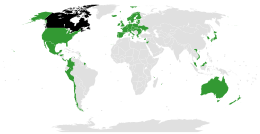
The North American Free Trade Agreement was an agreement signed by Canada, Mexico, and the United States that created a trilateral trade bloc in North America. The agreement came into force on January 1, 1994, and superseded the 1988 Canada–United States Free Trade Agreement between the United States and Canada. The NAFTA trade bloc formed one of the largest trade blocs in the world by gross domestic product.

The Free Trade Area of the Americas (FTAA) was a proposed agreement to eliminate or reduce the trade barriers among all countries in the Americas, excluding Cuba. Negotiations to establish the FTAA ended in failure, however, with all parties unable to reach an agreement by the 2005 deadline they had set for themselves.
A European Union Association Agreement or simply Association Agreement (AA) is a treaty between the European Union (EU), its Member States and a non-EU country that creates a framework for co-operation between them. Areas frequently covered by such agreements include the development of political, trade, social, cultural and security links.

James Gordon Carr was a Canadian politician, cabinet minister, journalist, and professional oboist. A member of the Liberal Party, he served as the member of Parliament for Winnipeg South Centre from 2015 until his death on December 12, 2022. Carr died days after his Private Members Bill, Bill C-235, An Act respecting the building of a green economy in the Prairies, passed the House and went to the Senate. He last served as the Chair of the Standing Committee on Public Safety and National Security, until his resignation on September 29, 2022.

Relations between Canada and the European Union (EU) and its forerunners date back to the 1950s. While the relationship is primarily an economic one, there are also matters of political cooperation. Canadians also use English and French — both European languages — as official and majority languages.

New Zealand is party to several free trade agreements (FTAs) worldwide.

The Canada–Panama Free Trade Agreement is a free trade agreement between Canada and Panama that went into effect April 1, 2013. It was concluded on August 11, 2009, by Canadian Prime Minister Stephen Harper and Panamanian President Ricardo Martinelli and signed by the two countries' trade ministers on May 14, 2010. It was effective by December 2012, after both countries' parliamentary approval. The agreement eliminates Panamanian tariffs on 90% of goods from Canada. The remaining 10% will be phased out within the next ten years. Canada will remove 99% of its tariffs on goods from Panama, while keeping those on some imports of sugar, poultry, eggs and dairy products. Panama will end its ban on beef from Canada which was initiated after cases of mad cow disease were found in Canada in 2003.
The Comprehensive Economic Partnership for East Asia (CEPEA) is a Japanese led proposal for trade co-operation, free trade agreement, among the 16 present member countries of the East Asia Summit. All those movements and efforts were taken over by the following Regional Comprehensive Economic Partnership.

The Comprehensive Economic and Trade Agreement (CETA) is a free-trade agreement between Canada and the European Union and its member states. It has been provisionally applied, thus removing 98% of the preexisting tariffs between the two parts.
The ASEAN–India Free Trade Area (AIFTA) is a free trade area among the ten member states of the Association of Southeast Asian Nations (ASEAN) and the Republic of India. The initial framework agreement was signed on 8 October 2003 in Bali, Indonesia. and the final agreement was on 13 August 2009. The free trade area came into effect on 1 January 2010. India hosted the latest ASEAN-India Commemorative Summit in New Delhi on 26 January 2018. In the financial year 2017–18, Indo-ASEAN bilateral trade grew by almost 14% to reach US$81.3 billion. India's imports from ASEAN were valued at US$47.13 billion while its exports to ASEAN stood at US$34.2 billion.

A commercial policy is a government's policy governing international trade. Commercial policy is an all encompassing term that is used to cover topics which involve international trade. Trade policy is often described in terms of a scale between the extremes of free trade on one side and protectionism on the other. A common commercial policy can sometimes be agreed by treaty within a customs union, as with the European Union's common commercial policy and in Mercosur. A nation's commercial policy will include and take into account the policies adopted by that nation's government while negotiating international trade. There are several factors that can affect a nation's commercial policy, all of which can affect international trade policies.

The European Union has concluded free trade agreements (FTAs) and other agreements with a trade component with many countries worldwide and is negotiating with many others. The European Union negotiates free trade deals on behalf of all of its member states, as the member states have granted the EU has an "exclusive competence" to conclude trade agreements. Even so, member states' governments control every step of the process :

The United States-Chile Free Trade Agreement is a free trade agreement (FTA) between the United States and Chile signed on June 6, 2003. The pact came into force on January 1, 2004. On that date, tariffs on 90% of U.S. exports to Chile and 95% of Chilean exports to the United States were eliminated. The agreement also established that Chile and the U.S. will establish duty-free trade in all products within a maximum of 12 years (2016). In 2009, bilateral trade between the United States and Chile reached US$15.4 billion, a 141% increase over bilateral trade levels before the U.S.-Chile FTA took effect. In particular, U.S. exports to Chile in 2009 showed a 248% increase over pre-FTA levels.

The Regional Comprehensive Economic Partnership is a free trade agreement among the Asia-Pacific nations of Australia, Brunei, Cambodia, China, Indonesia, Japan, South Korea, Laos, Malaysia, Myanmar, New Zealand, the Philippines, Singapore, Thailand, and Vietnam. The 15 member countries account for about 30% of the world's population and 30% of global GDP, making it the largest trade bloc in history. Signed in November 2020, RCEP is the first free trade agreement among the largest economies in Asia, including China, Indonesia, Japan, and South Korea.

The Comprehensive and Progressive Agreement for Trans-Pacific Partnership (CPTPP), also known as TPP11 or TPP-11, is a trade agreement between Australia, Brunei, Canada, Chile, Japan, Malaysia, Mexico, New Zealand, Peru, Singapore, and Vietnam. It evolved from the Trans-Pacific Partnership (TPP), which was never ratified due to the withdrawal of the United States. The eleven members have combined economies representing 13.4 percent of global gross domestic product, at approximately US$13.5 trillion, making the CPTPP one of the world's largest free-trade areas by GDP, along with the United States–Mexico–Canada Agreement, the European single market, and the Regional Comprehensive Economic Partnership. The United Kingdom and the present members formally signed an accession protocol on 16 July 2023 and will join the agreement when it has been ratified by all parties, or after 15 months if the UK and a majority of CPTPP parties have ratified it.

The Agreement between the United States of America, Mexico, and Canada (USMCA) is a free trade agreement between the United States, Mexico, and Canada. It replaced the North American Free Trade Agreement (NAFTA) implemented in 1994, and is sometimes characterized as "NAFTA 2.0", or "New NAFTA", since it largely maintains or updates the provisions of its predecessor. USMCA is one of the world's largest free trade zones, with a population of more than 510 million people and an economy of $30.997 trillion in nominal GDP — nearly 30 percent of the global economy.

South Korea has concluded free trade agreements (FTAs) and other agreements with a trade component with countries around the world and is negotiating with others.
Vietnam, although a relatively young and small nation, has successfully established trade relations with dozens of countries worldwide. This is especially evident in the number of free trade agreements (FTAs) that the country has signed and is participating in. Being part of the Association of Southeast Asian Nations (ASEAN), economic opportunities for Vietnam expands beyond bilateral trade agreements with specific countries to include multilateral trade agreements via the ASEAN Free Trade Area (AFTA).














